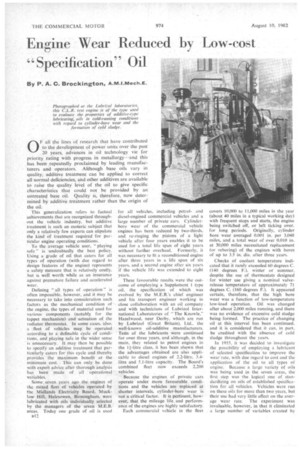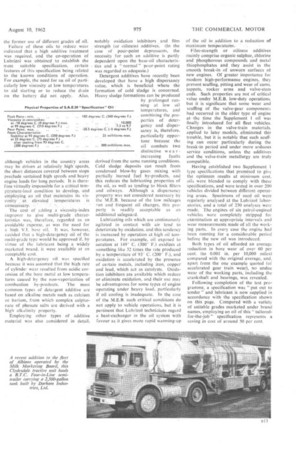Engine Wear Reduced b " Specification" Oil
Page 46

Page 47

If you've noticed an error in this article please click here to report it so we can fix it.
By P. A. C. Brockington, OF all the lines of research that have contributed to the development of power units over the past 20 years, advances in oil technology vie for priority rating with progress in metallurgy—and this has been repeatedly proclaimed by leading manufac
turers and operators. Although base oils vary• in quality, additive treatment can be applied to correct all normal deficiencies, and other additives are available tO raise the quality level of the oil to give specific Characteristics that could not be provided by an untreated base oil. Quality is, therefore, now determined by additive ,treatment rather than the origin of the oil.
This generalization refers to factual achievements that are recognized through out the vehicle industry, hut additive treatment is such an esoteric subject that only a relatively few experts can stipulate the kind of treatment required for particular engine operating conditions.
To the average vehicle user, " playing safe" is undoubtedly the best policy. Using a grade of oil that caters for all types of operation (with due regard to design features of the engine.) represents a safety measure that is relatively costly, but is well worth while as an insurance against premature failure and accelerated wear.
Defining " all types of operation" is often impossible, however, and it may be necessary to take into consideration such factors as the mechanical condition of the engine, the types of material used for various components (notably for the tappet mechanism) and actuation of the radiator thermostat In some cases, also. a fleet of vehicles may be operated according to a definable cycle of conditions, and playing safe in the wider sense . is unnecessary. It may then be possible to specify an additive treatment that particularly caters for this cycle and thereby provides the maximum benefit at the minimum cost. This can only be done with expert advice after thorough analysis has been made of all operational variables.
Some seven years ago the engines of the mixed fleet of vehicles operated by the Midlands Electricity Board. Mucklow Hill, Halesowen, Birmingham, were lubricated with oils individually selected by the managers of the seven M.E.B. areas. Today one grade of oil is used B1 2 for all vehicles, including petroland diesel-engined commercial vehicles and a large number of private cars. Cylinderbore wear of the commercial vehicle engines has been reduced by two-thirds, and re-ringing the pistons of a light vehicle after four years enables it to be used for a total life span of eight years without further overhaul. Formerly, it was necessary to fit a reconditioned engine after three years in a life span of six years, and a second engine after six years if the vehicle life was extended to eight years.
These favourable results were the outcome of employing a Supplement I type oil, the specification of which was evolved by the M.E.B.'s chief engineer and his transport engineer working in close collaboration with an oil company and with technicians of Lubrizol International Laboratories of " The Knowle," Hazelwood, near Derby, which are run by Lubrizol (Great Britain). Ltd.. the well-known oil-additive manufacturers. Tests of the lubricants were continued for over three years, and although, in the main, they related to petrol engines in the 1+-litre class, it has been shown that the advantages obtained are also applicable to diesel engines of 2.2-1itre, 3.4litre and 5.1-litre capacity. The Board's combined fleet now exceeds 2,200 vehicles.
Because the engines of private cars operate under more favourable conditions and the vehicles are replaced at shorter intervals, cylinder-bore wear is not a Critical factor. It is pertinent, however, that the mileage life and performance of the engines are highly satisfactory.
Each commercial vehicle in the fleet
covers 10,000 to 11,000 miles in the year (about 40 miles in a typical working day) with frequent stops and starts, the engine being switched off, or left ticking over. for long periods. Originally, cylinder bore wear averaged 0.001 in. per 3,048 miles, and a total wear of over 0.010 in. at 30,000 miles necessitated replacement (or reboring) of the engines with bores of up to 3.5 in. dia. after three years.
Checks of coolant temperature indicated that it rarely exceeded 60 degrees C. (140 degrees F.). winter or summer, despite the use of thermostats designed for winter use giving a nominal valverelease temperature of approximately 71 degrees C. (160 degrees F.). It appeared certain, therefore, that the high bore wear was a function of low-temperature low-load operation. Oil was changed after about 2,000 miles running, and there was no evidence of excessive cold sludge being formed. The practice of changing oil at this interval has been continued, and it is considered that it can, in part, be credited with the absence of cold sludge throughout the years.
In 1955, it was decided to investigate the possibility of employing a lubricant of selected specification to improve the wear rate, with due regard to cost and the application of the oil to all types of engine. Because a large variety of oils was being used in the seven areas, the first step was the logical one of standardizing on oils of established specification for all vehicles. Vehicles were run on these oils for more than two years, but their use had very little effect on the average wear rate. The experiment was invaluable, however, in that it eliminated a large number of variables created by
the former use of different grades of oil.
Failure of these oils to reduce wear indicated that a high additive treatment was required, and the co-operation of Lubrizol was obtained to establish the most suitable specification, certain features of this specification being related to the known conditions of operation. For example, the need for an oil of particularly low viscosity at low temperatures to aid starting or to reduce the drain on the battery did not apply. Also,
although vehicles in the country areas may be driven at relatively high' speeds, the short distances covered between stops preclude sustained high speeds and heavy engine loads for long Periods: It is therefore virtually impossible for a critical temperatnee'71oad condition to develop, and employing an oil that maintains its viscosity 'at elevated temperatures is unnecessary:
The cost of adding a viscosity-index iroprover to give multi-grade characteristics. was, therefore, regarded as an avoidable expense, as was the need for a high V.I. base oil, It was, however, decided that a high-detergency oil of the multi-grade type would be approved if, by ‘irtue of the lubricant being a widely marketed brand. it were available at an acceptable cost.
A high-detergency oil was specified because it was assumed that the high rate of cylinder wear resulted from acidic corrosion of the bore metal at low temperatures caused by the non-vaporization of combustion by-products. The most common types of detergent additive 'are based on alkaline metals such as calcium or barium, from which complex sulphonate of phenate salts are derived with a high alkalinity property.
Employing other types of additive material was also considered in detail, notably oxidation inhibitors and film strength (or oiliness) additives, (In the case of pour-point depressants, the necessity for such an additive is Partly dependent upon the base-oil characteristics and a " normal" pour-point rating was regarded as adequate.) Detergent additives have recently been developed that have a high dispersancy value, which is beneficial where the formation of cold sludge is concerned. Heavy sludge formations can be produced by prolonged running at low oil temperatures, and combining the properties of detergency and dispersancy is, therefore, particularly opportune because the oil combats two distinctive wear
ficaticin " Oil .182 degrees C. (360 degrees F.) 10,000 -7,3 to 9.7 -20.5 degrees C. (-5 degrees F.)
25 millilitres max, „ 300 .millilitres max.
increasing faults derived from the same running conditions. Cold sludge deposits can result from condensed blow-by gases mixing with partially burned fuel by-products, and this reduces the lubricating properties of the oil, as well as tending to block filters and oilways. Although a dispersancy property was not considered necessary by the M.E.B. because of the low mileages n and frequent oil changes, this property is readily acceptable as an additional safeguard.
Lubricating oils which are continuously agitated in contact with air tend to deteriorate by oxidation, and this tendency is increased by operation at high oil temperatures. For example, oil exposed to aeration at 149° C. (300' F.) oxidizes at something like 32 times the rate produced by a temperature of 93 C. (200' F.), and oxidation is accelerated by the presence of certain metals, including iron, copper and lead, which act as catalysts. Oxidation inhibitors are available which reduce or eliminate oxidation, and their use may be advantageous for some types of engine operating under heavy load, particularly if oil cooling is inadequate. In the case of the M.E.B. such critical conditions do not apply to vehicle operations, but it is pertinent that Lubrizol technicians regard a heat-exchanger in the oil system with favour as it gives more rapid warming-up of the oil in addition to a reduction of maXimum temperatures. .
Film-strength or oiliness additives mainly comprise organic sulphur, chlorine and phosphorous compounds and metal thiophosphates and they assist in the smooth break-in of unworn surfaces of new engines. Of greater importance for modern high-performance engines, they prevent scuffing, pitting and wear of cams, tappets, rocker arms and valve-stem ends. Such properties are not of critical value under M.F.B. low-duty operations. but it is significant that some wear and scuffing of the valve-gear components had occurred in the older type of engine at the time the Supplement 1 oil Was finally introduced for all fleet vehicles.
Changes in the valve-train materials. applied to later models, eliminated this trouble, but it is notable that such scuff ing can occur particularly during the break-in period and under more arduous service conditions, unless the additives and the valve-train metallurgy are truly compatible.
Having established two Supplement 1 type specifications that promised to give the optimum results at minimum cost, oils were blended to comply with these specifications, and were tested in over 200 vehicles divided between different operat ing areas. Specimens of used oil were regularly analysed at the Lubrizol labor atories, and a total of 250 analyses were made. The engines of six petrol-engined vehicles were completely stripped for examination at appropriate intervals and wear measurements made of all the working parts. In every case the engine had been running for a considerable period before the new oil was introduced, Both types of oil afforded an average reduction in bore wear of over 60 per cent. (to 0.001 in. per 10,000 miles) compared with the original average, and. apart from the one example quoted (of accelerated gear train wear), no undue wear of the working parts, including the crankshaft and bearings, was revealed.
Following completion of the test programme, a specification was "put out to tender" and lubricant is now supplied in accordance with the specification shown on this page. Compared with a variety of suitable grades marketed under brand names, employing an oil of this " tailoredfor-the-job" specification represents a saving in cost of around 50 per cent.
















































































































